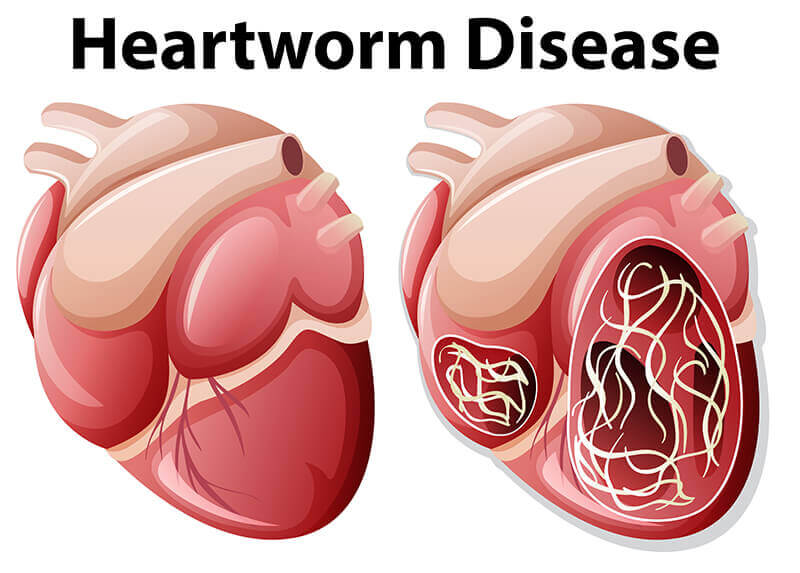The Main Signs of Dirofilariasis in Dogs


Written and verified by the biologist Paloma de los Milagros
Dirofilariasis is a cardiopulmonary illness more commonly known as heartworm. These parasites dwell mainly in the right ventricle and pulmonary artery of their host. However, they can also migrate to other parts of the body in the most serious of cases.

Dogs aren’t the only animals that can suffer from dirofilariasis. The infection can also affect cats, and wolves, foxes, and ferrets can all fall victim to heartworm disease. The transmission of this parasite occurs by means of a vector. In this case, the vector is a mosquito belonging to the genuses Aedes, Anopheles, Culex, among others.
These mosquitoes ingest the microfilariae that they later pass on to their victims by means of a mosquito bite.
The main signs of dirofilariasis in dogs
In the first stages of this infection, animals don’t display any apparent symptoms. However, after a year, or even several years after the infection, dogs will experience the following disorders:
- A mild and persistent cough
- Reluctance towards exercise as well as fatigue after performing moderate physical activity
- Lack of appetite resulting in weight loss
- Cardiac insufficiency and abdominal swelling – these symptoms are the result of liquid retention, and both appear once the disease is very advanced
- Last of all, in cases where a dog’s death is imminent, caval syndrome takes place. This begins with respiratory difficulties, the presence of pale gums, bloody urine, and finally, blockage of the animal’s blood flow, causing the heart to collapse.

All dogs should receive preventative treatment in the form of a monthly pill. Just the same, owners must also take their pets for an annual physical check-up, so that their veterinarian can rule out possible infection. The effectiveness of these pills against heartworm is very high. However, it’s extremely important that owners are disciplined when it comes to administering the medication every month. Foregoing just one dose can put animals at risk.
Dogs that are infected with the Dirofilaria immitis parasite can have more than 30 worms in their hearts. The more worms an animal has, the more serious the symptoms will be.
At the same time, as time goes by and symptoms become more evident, the more conclusive diagnosis will be. Physical examinations, X-rays, ultrasounds and different types of blood work will be necessary when it comes to confirming the presence of an infection.
Measures for the prevention of dirofilariasis in dogs
The lethality of dirofilariasis in dogs makes it essential for owners to carry out the proper prophylactic treatment. Besides traditional oral options, there are also topical medications as well as injections. Each treatment method has a specific frequency when it comes to its administration.
All of these medications act to eliminate immature heartworm larvae. This includes the infectious larva that vector mosquitoes deposit through their bites, as well as in the larva stage.
After a period of approximately 50 days, immature larvae will move onto the adult stage. At this point, preventative treatments are ineffective. Given the brevity of this parasite’s life cycle, it’s extremely important to be strict when carrying out whatever preventative measures your veterinarian has indicated.

In the unfortunate case where a dog manages to become infected, the animal’s vet will establish a protocol. The type of treatment a professional chooses has to do with how much the infection has advanced, as well as the symptoms.
Treatment
Treatment has the best chances of being successful in asymptomatic cases. However, the seriousness of an animal’s symptoms isn’t necessarily an indication of the seriousness of its illness. In fact, the sickest dogs and those with the greatest number of worms may show the least signs of infection.
Dirofilariasis in dogs is one of the diseases that has caused the greatest number of deaths in domestic dogs. This is true not only in the United States but also around the globe. However, it’s this same massive impact that has allowed for the widespread study of this infection. As a result, science has been able to discover effective treatment options to guarantee the health of man’s best friend.
All cited sources were thoroughly reviewed by our team to ensure their quality, reliability, currency, and validity. The bibliography of this article was considered reliable and of academic or scientific accuracy.
- American Heartworm Society. Heartworm Basics. (S.f). Recuperado de https://www.heartwormsociety.org/pet-owner-resources/heartworm-basics
- Carretón, E.; Montoya-Alonso, J. A.; Falcón-Cordón, Y.; Falcón-Cordón, S.; Diosdado, A.; Gómez, P. J.; González, M. J.; Simón, F.; Morchón, R. (2018). Gui@ Vet. Sintomatología, diagnóstico, tratamiento y control de la dirofilariosis cardiopulmonar. Recuperado de https://www.portalveterinaria.com/animales-de-compania/articulos/27733/sintomatologia-diagnostico-tratamiento-y-control-de-la-dirofilariosis-cardiopulmonar.html
This text is provided for informational purposes only and does not replace consultation with a professional. If in doubt, consult your specialist.